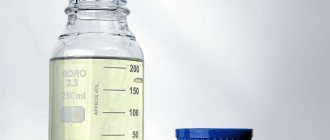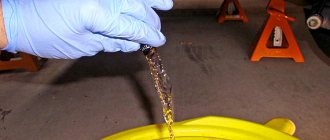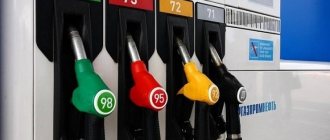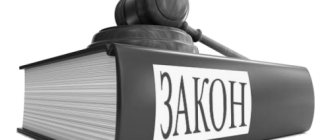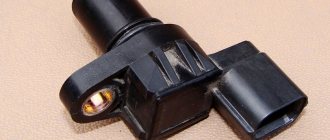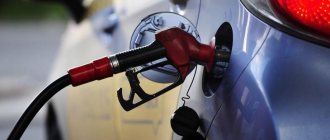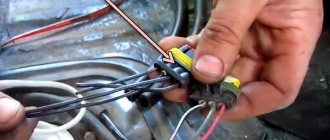Filling a car with gasoline is an ordinary task for drivers. In large cities, the chance of purchasing fuel of inadequate quality is negligible: they are all filled with networks of reliable gas station complexes. Today, it is extremely rare at gas stations to dilute fuel with water or various unknown additives. Only small gas stations can do this. You should purchase “power” for your car engine only at proven gas stations of a large network. After all, the cost of eliminating all the troubles caused by the entry of “hot stuff” into the gas tank can seriously hit your pocket. What is bad gasoline and what are the symptoms that indicate that such fuel was purchased at a gas station?
What kind of gasoline is called bad?
Poor quality gasoline can only be determined through laboratory testing. The driver's only tool is his eyes. The fuel should be clean and transparent in appearance. Gasoline from the bottom of a dirty container is also considered bad. This problem is typical even at gas stations of some reputable large chains. It is much worse when the manufacturer increases the octane number of gasoline through an additive package. The quality of normal fuel has long been regulated by standards. These standards allow the content of a certain amount of additives, benzene, and metals. If gasoline does not meet any criterion, it is called bad.
The following indicators fall under the standards:
- Octane number: indicates the degree of stability of the fuel before detonation.
- Sulfur: the less quantity it is present in gasoline, the better quality it is. When burned, it releases sulfur oxides, which form sulfuric acid with water vapor, which destroys virtually everything it touches.
- Water: the most common liquid on the basis of which “bodyaga” is diluted.
- Benzene: The presence of benzene in high-octane fuel is gradually being reduced due to the high toxicity of combustion products.
- Esters, alcohols: the percentage of alcohols included in high-quality gasoline is controlled. At an acceptable level (approximately 3-5%) they do not harm the engine. But a higher percentage of content contributes to increased consumption and the formation of fuel system plugs under the influence of high ambient temperatures.
- Arenas: They are also called aromatic carbons. Increases octane number. They have a detrimental effect on the fuel system pipes.
The driver can recognize the signs of bad gasoline only by the behavior of the car. Modern cars with different types of internal combustion engines react differently to fuel with an increased octane number. Sometimes the additive package is quite well selected and skillfully introduced. Most cars have at least once “eaten” and successfully “digested” bad gasoline poured into the gas tank. But it may happen that the engine of your particular car cannot withstand fuel with an increased content of naphthalene, ethyl, and acetone. That's why it's important to know the signs of low-quality gasoline.
How to determine if you have filled up with low-quality gasoline
Almost immediately the car will show all the signs of a poor-quality fuel mixture. It will become clear as soon as you set off and begin to accelerate, if you start at all, of course. But you can determine these characteristic features only if you have been driving a car for some time, not yesterday, as they say, you bought it, then everything will immediately become clear to you.
What will be the symptoms of poor quality fuel?
You don't need to be a specialist or a driver with many years of experience to recognize the main symptoms of bad gasoline. They are as follows:
- The car doesn't start well.
- The car engine began to stall.
- Unstable speed at idle.
- The dynamics of the car dropped noticeably.
- Slow response of the gas pedal to pressure.
- During acceleration the car jerks.
- Knocks from the engine (probably detonation) became clearly audible.
- Fuel consumption increased by 15-20%.
- The color of the exhaust gases has changed.
All these symptoms indicate that bad gasoline was poured into the gas tank. It's not uncommon for the Check Engine light on your dashboard to turn on. You can unscrew the spark plugs and inspect their condition: red or black soot will indicate the need to change your usual gas station.
Jerks during acceleration
If the fuel is good, the car starts and picks up speed smoothly. If gasoline contains foreign impurities, the vehicle begins to twitch during acceleration. The driver feels as if someone is releasing the gas pedal for a split second, then immediately pressing it again. If you don’t take action and continue to drive on such fuel, the “jabs” will become more frequent. Moreover, they will be observed not only during acceleration.
What to do in this case
First of all, stop the car and turn off the engine. The driver should get rid of low-quality fuel: pour everything out of the tank without a trace, then rinse the tank, fuel system, clean the injectors, replace the spark plugs. It would be even better to entrust this work to professional auto mechanics. Do not continue driving, call a tow truck and take the car to a service station. First, find the receipt from the gas station - this is the only evidence in case of further proceedings. Ideally, you should act like this if you fill up with bad gasoline:
- turn off the engine and call a tow truck;
- we return to the gas station, explain the claim and present the receipt;
- We call a mobile laboratory expert to analyze the fuel.
Situations are different: sometimes it is difficult to stop driving and call a tow truck. This is usually hampered by the weather (severe frost) and distance from the nearest populated area. But remember that by continuing to use, you act at your own peril and risk. If the car is new, the dealer has the right to remove it from the warranty: a catalyst destroyed as a result of operating the car on low-quality fuel is the responsibility of the driver. Even one unsuccessful refueling can leave a serious mark.
Consequences of bad gasoline:
- the operation of the entire fuel system is disrupted: sensors, filters suffer, injectors wear out;
- spark plugs deteriorate: it is the sparking elements that are the first to take a serious blow;
- valves wear out: exhaust valves are especially vulnerable due to incomplete combustion of the combustible mixture;
- further the catalyst is destroyed: the still “burning” mixture leaving the exhaust system will melt or destroy the catalyst, which will potentially lead to ceramic dust entering the engine cylinders through the EGR valve;
- parts of the cylinder-piston group suffer: due to uncontrolled ignition (detonation), the engine overheats, which leads to wear of the pistons and rings, scuffing occurs in the cylinders, compression and power drop.
These breakdowns do not occur overnight. Only systematic operation of the car on bad gasoline gradually reduces the engine's life.
What happens if you always fill with bad fuel?
For diesel cars, this situation is not at all pleasant. Diesel fuel must be clean, have a certain chemical composition, and not freeze in winter. You can use a number of additives, but in Russia there are not as many good chemicals as there are various fakes. So you should choose a gas station for a diesel car that you are completely confident in. As for gasoline, if you constantly use bad fuel, expect the following results:
- fuel consumption will be at least 10% higher than the rated value; often on older cars this figure becomes even higher, and owners begin to look for the cause of such problems;
- the trip by car will not be dynamic and pleasant; difficulties with the engine will constantly arise, which actively interfere with the normal operation of the vehicle;
- fuel filters will become clogged quite quickly, which indicates the low quality of the gasoline composition and the presence of various types of inclusions that remain on the purifier;
- the fuel pump will work unstably, the filter installed in its system will become clogged, which manufacturers generally do not recommend changing under normal operating conditions;
- The injector system, which also becomes clogged with various small inclusions and solid particles, will fail faster; the injectors will have to be washed quite often.
Cleaning injectors is an expensive and difficult task that can only be done efficiently at a service station. As a result, it is better to refuel at an expensive and high-quality gas station than to go to the station every six months and clean the fuel supply system, change the filter and service the gas pump. This suggests that finding a good gas station is an inevitable process to achieve the necessary results in driving your vehicle.
7 signs of poor quality fuel
| 6 signs of a reliable gas station
|
How to avoid fuel problems
Try to follow simple rules:
- Buy gasoline only from gas stations you trust. For preventive purposes, periodically unscrew the spark plugs. Carbon deposits and deposits are a sure indicator of the use of low-quality fuel.
- Before arriving at a new gas station, pay attention to the landscaping of the territory: cleanliness, well-groomed conditions - indicators of the company’s growing reputation;
- Avoid buying “European fuel” at a small and unknown gas station.
- Be skeptical about low prices.
- Don't forget to pick up your receipt and keep it for as long as possible.
These tips will help you avoid many problems when purchasing fuel. Don't skimp on gas. It is better to overpay the “ruble” than to repair serious damage to the engine, fuel system, or catalyst.
Increased fuel consumption
The change in the amount of fuel consumed is more noticeable if you refuel the car in small portions. Typically, the driver makes the same journey every day (to work and back, to the store, shopping center). Therefore, most often the motorist guesses how long the filled gasoline should last him.
If you find that the amount of fuel is not enough, you need to be wary. You can check the condition of the exhaust: when refueling with bad fuel, dirty smoke with a pungent odor often begins to come out of the pipe. If your fears are confirmed, you need to change the gas station.
Taste and color
Is it possible to detect bad gasoline by eye? Sometimes yes, but you will need transparent containers, and gas stations don’t like to pour fuel into plastic, citing safety precautions. So stock up on a large glass bottle for experiments.
Normal gasoline is an almost colorless liquid, with a slight blue or pale yellow tint. A red tint indicates the presence of ferrocenes - prohibited metal-containing additives - in the composition. Ferrocenes also leave a coating of the same color on spark plugs. But spark plugs are the least of the troubles: metal deposits cover all the insides of the engine, from the combustion chamber to lambda probes (oxygen sensors), rendering them inoperable.
The rich yellow color and pungent smell of fuel do not indicate the tricks of Vasily Alibabaevich, who diluted gasoline with donkey urine, but an excess of cheap octane-increasing additives based on monomethylaniline (MMA). Such gasoline is most likely made from cheap AI-80, the octane number of which has been raised by an exorbitant amount of additives that pollute the engine.
Alas, other fuel surprises cannot be identified by eye. And there are many of them: low octane number (the cause of destructive detonation), resins dissolved in gasoline, polluting the fuel system and combustion chamber; carcinogenic benzene, sulfur, water - all this can be found in fuel.
The main problem with today's low-grade gasolines is the presence of methanol. Technical regulations prohibit its use, but in the worst samples the share of methanol reaches 30%! Such gasoline is a death sentence for the catalyst (exhaust neutralizer) and oxygen sensors.
Five signs that you were filled with bad gasoline
In case of refusal, we call independent experts, and at the same time the traffic police officers.
Suspicious fuel from the gas tank should later be drained, for which it makes sense to use a tow truck and tow the car to a service center. However, in a number of cases, after refueling at a suspicious gas station, no strong detonation of the engine is observed, but nevertheless, the car’s throttle response decreases before our eyes, the reactions to the gas supply are dulled, and the engine, as they say, stops pulling. Consider yourself lucky if the cause of your “vegetable” reactions was refueling with low-octane gasoline.
In this case (if the tank is not full), you can simply add good fuel at a proven or trusted network gas station. In other cases, it makes sense to completely drain the fuel from the tank, and possibly also flush the fuel system.
A litmus test can literally be an ordinary sheet of paper. Drop the fuel that aroused your suspicion on it. If the substance is greasy and does not dry quickly, this is a sign that the fuel is full of impurities.
Black smoke from the exhaust pipe after refueling may indicate that you were filled with either an absolute counterfeit product, or, alternatively, diesel fuel instead of gasoline, or vice versa (the effect of black smoke can be caused by additives that do not match the type of your engine).
However, most often we are talking about counterfeit fuel, which cannot burn completely and is discharged along with the exhaust gases. A special situation with diesel units.
Refueling with low-quality or low-octane gasoline usually also leads to a sharp increase in fuel consumption, which will sooner or later be signaled by the on-board computer.
Excessive consumption can occur due to a clogged fuel filter (the control unit will try to normalize the fuel supply and send a signal about the need to open the injectors for a long time), failure of the mass air flow sensor (it either becomes clogged or the signal in the power connector disappears), as well as coked cylinder head exhaust ports or clogged catalytic converter.
Source
The Right Action
- You need to rinse the tank, naturally draining all the gasoline from there
- In this case, the fuel line requires cleaning
- Injectors are removed and checked
And it is recommended to do all this work in your service station. In addition to these procedures, they will be able to identify other damage.
Well, and most importantly, no matter what the cost of the work, after the examination you have appointed and if low-quality gasoline is identified, the gas station is obliged to pay you all your repair costs.
Let's summarize: Yes, you can fill the tank until the tank is full and get rid of the bad gasoline, but you should remember that even if you filled it up to full with 98, it still will not get rid of impurities in the total mass.
And it’s not yet clear whether this will save money or add problems in the future.
Or follow a different algorithm. Tow the car to a service station, pay for repairs, but try to prove the purchase of low-quality gasoline and return all expenses at the expense of the unscrupulous gas station.
It's up to you to decide, but it also happens that assumptions about problems in the car due to low-quality fuel are not confirmed. In this case, be prepared to pay for the examination.
